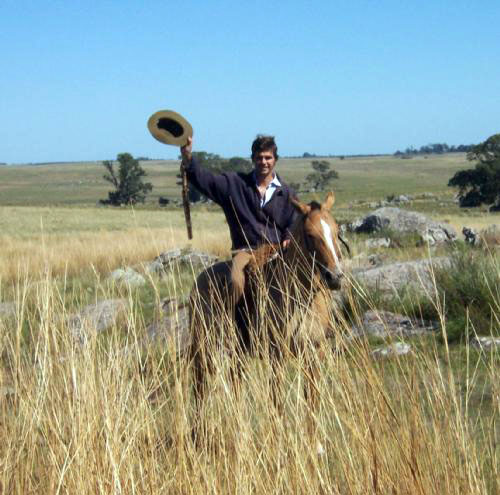Criollo Horses in Uruguay
To talk about of the Criollo horse is to talk about the Gaucho... proud, adventurous, simple and noble.
by Ricardo Bonner
The term criollo is used in South America, and specifically in Uruguay, to describe animal breeds, food, events, etc., that are common, characteristic, or emblematic of the country.
Originally used for war, the Criollo horse is the direct descendant of some of the best European horses, brought by the Spanish conquistadors to the New World during the 16th century. Natural selection under the harsh conditions of life in the vast South American plains gradually transformed this horse into the symbol of the legendary Gaucho (cowboy) lands.

Gaucho Horses
To talk about of the Criollo horse is to talk about the Gaucho. The Gaucho is proud and adventurous, but at the same time simple and noble. Throughout history, the Gaucho has been the master of the pampas (grasslands), even though he possessed no lands.
Rain or shine, he spent most of his life travelling cross-country with his horse and dogs, who became inseparable and faithful companions. The gaucho slept under the stars with his recado, a traditional Gaucho saddle made of layers of cloth and sheepskin. The recado was comfortable for long rides by day and used as a sleeping bag at night. At his back, the Gaucho kept a long knife, which doubled as a tool and weapon. During his long hours of solitude, he drank mate, an herbal tea-like drink brewed from the dried leaves and stems of the yerba mate plant grown in South America.
Almost all daily activities (bathing, hunting, herding ...) were performed from the back of his horse, giving credibility to the saying, “a gaucho without a horse is like a man without legs.” Though modern life has led to the end of the nomadic culture, gauchos still exist at every corner of the Uruguayan countryside with the essence of their character almost untouched.
Horsemanship has always been the measure of a Gaucho’s ability. His valour and strength is demonstrated through his proficiency at cattle herding, lassoing and traditional horseback competitions. The best horses were therefore those owned and trained by the gauchos, who thus unassumingly initiated human selection of the Criollo Horse.

"Welcome to the Timote Lands", photo taken by Miranda Crowhurst.
The horse of the Pampas
The Criollo, also known as" the horse of the Pampas," was almost forgotten during the 19th century, when different foreign breeds were brought to Uruguay. However, its outstanding values were acknowledged by cattle breeders, who used them for work on a daily basis. The best mares and stallions of the region were carefully selected, allowing the development of the Criollo breed to become a reality. In the early 20th century it was officially recognized at the international level as the local breed of the Southern South American countries. In 1941 The Criollo Horse Breeders Society of Uruguay was founded, thus ensuring the continuation of the breed at the national level. The Criollo horse was formally declared in 2003 as an official symbol of the Uruguayan cultural heritage.
Through aforementioned process of natural selection, Gauchos and breeders shaped a solid, functional animal that is exceptionally noble and hardy.
Criollo Horse Characteristics
The Criollo is a medium-sized horse measuring 13.2 to 15.0 hands. (1.38 to 1.52 meters) Its powerful body and strong endurance qualities, allow the horse to survive adverse environmental conditions. In spite of its strong character it is easy to train, intelligent and versatile. The Criollo fears nothing and goes anywhere. The breed excels in the great outdoors and is ideal for long voyages. It may be ridden for up to 150 miles during one week with no special training and no other nourishment than the grass upon which it can nibble along its route. The Criollo has also shown excellent skills for modern equine sports. It is the ideal and irreplaceable horse for the Uruguayan lands and its people.
Only in the realm of the natural pampas where it was born, can the full pleasure of riding a Criollo in the Gaucho way can be experienced.
About the Author
Ricardo Bonner grew up at his grandparents’ estancia (ranch) in Uruguay, where he learned to ride even before he could talk. Considered an expert horseman and horse breeder at his family ranch, Espina de Cruz, he won several riding competitions in national horse shows. He was also an Economy Analyst who ran a company devoted to promoting ecotourism, based on the natural and cultural interests of the Uruguayan pampas, the local estancias and the Criollo horses. Ricardo speaks Spanish, English and some Portuguese and now lives in Baltimore, MD.




